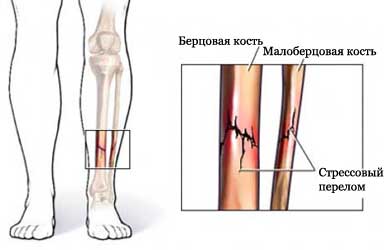Stress fracture – Stress fracture
Description fatigue fracture
Stress fracture – a tiny crack in the bone. Most stress fractures occur in the lower leg and foot. They can also occur in the bones of the hip and other bones. Most stress fractures can heal on its own. Nonetheless, some of them may lead to a complete fracture, or may require surgery.

Causes of stress fracture
Fatigue fracture does not occur from a blow to the bone. It is most commonly caused by repetitive or excessive load. Some causes of fatigue fracture:
- Too rapid an increase in load (the most common cause);
- Wearing uncomfortable or old shoes.
Status bone fracture in the presence of fatigue may worsen with continued physical exertion. Smoking can also aggravate the condition of stress fracture, because prevents bone healing.
Risk factors for stress fracture
Factors, increase the risk of fatigue fracture include:
- Paul: female
- Some sports, especially jumping or running:
- Tennis;
- Run, especially for long-distance;
- Gymnastics
- Dancing;
- Basketball;
- Amenorrhea (only for women)
- Reducing the thickness or density of bone;
- Low muscle strength and flexibility;
- Overweight or underweight;
- Poor physical condition.
Symptoms of fatigue fracture
Symptoms include:
- Localized pain in the bones;
- Pain at the pressure directly on the fracture and the area around it;
- Pain when the load on the injured leg;
- Swelling and heat at the injury site.
Diagnosis of fatigue fracture
The doctor will ask about your symptoms, recent physical activity, About, how the accident occurred, will examine the area, which is suspected fracture.
Tests may include:
- Roentgen – test, which uses X-rays, to take a picture of structures inside the body, especially bones;
- Stress fractures are very tiny and usually not seen on an x-ray at least two weeks after the onset of symptoms;
- MRT – test, which uses magnetic waves, to find swelling and inflammation within the bone;
- X-ray examination of bones – test, that uses short-lived radioactive substances, to find the location of a stress fracture.
Treatment of fatigue fracture
Treatment includes:
Medications
Nonsteroidal anti-inflammatory drugs (NSAIDs) can relieve pain, but among experts there is no unequivocal opinion about their use for stress fractures. Quite possible, NSAIDs can negatively affect fracture healing.
Recreation
Rest is the most important event in the treatment of stress fractures. We must avoid actions, which caused the destruction of bone and any other action, that cause pain. For relaxation, take at least 6-8 weeks.
Crutches or a cane
You may need crutches or a cane, to reduce pressure on the injured leg.
The resumption of daily activities
Talk to your doctor about, when you can go back to work.
General recommendations for a speedy recovery:
- Do the exercises with small loads, enjoy a swim or bike riding;
- Gradually you can increase the load, starting with a short walk;
- Once you are able to walk quickly and without pain, You can even increase the load, eg, do some light jogging;
- You can return to normal activities, if you do not feel pain in the injured bone.
Prevention of stress fractures
To prevent stress fractures:
- Wear comfortable shoes;
- Gradually increase the load on the bones;
- Eat a healthy diet, including products, rich in calcium and vitamin D;
- Avoid smoking.
